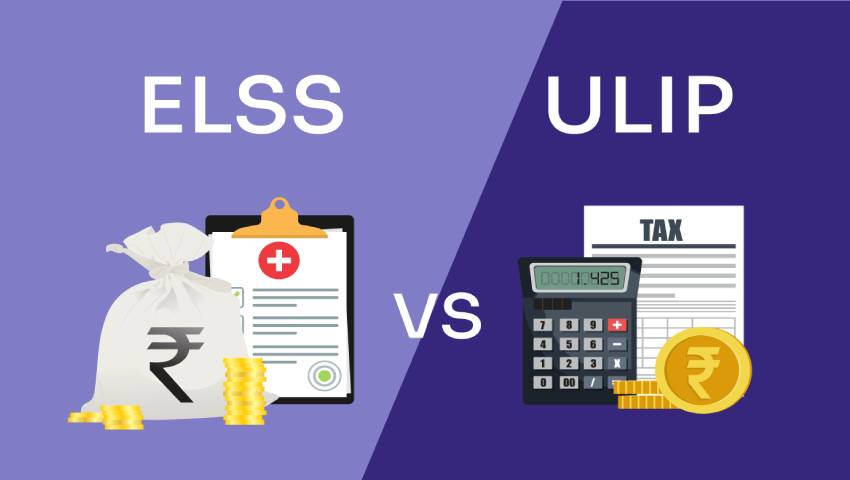
- 07/04/2025
- MyFinanceGyan
- 528 Views
- 4 Likes
- Mutual Fund, Finance, Investment
ULIP vs ELSS – A Comparative Analysis
When it comes to saving taxes and investing smartly, two popular options often come into the spotlight — Equity-Linked Savings Schemes (ELSS) and Unit-Linked Insurance Plans (ULIPs). Both fall under the benefits of Section 80C of the Income Tax Act, which allows deductions up to ₹1.5 lakh per year. However, they serve very different purposes and come with distinct features.
Let’s break them down and understand the key differences to help you choose the right one for your financial goals.
Understanding ELSS:
An ELSS is a type of mutual fund that mainly invests in equity and equity-related instruments. These funds are known for their potential to deliver high returns over the long term. Since the returns are linked to market performance, they tend to outperform traditional fixed-income instruments. However, with higher return potential comes a higher risk due to market fluctuations.
One of the key features of ELSS is its short lock-in period of just three years, which is the shortest among all tax-saving investment instruments. Once the lock-in period is over, investors can redeem or stay invested for as long as they wish.
Understanding ULIP:
ULIP is a hybrid financial product that offers both investment and insurance under a single plan. A portion of the premium you pay goes toward life insurance coverage, and the rest is invested in market-linked funds such as equity, debt, or a mix of both.
ULIPs come with a five-year lock-in period, which is longer than ELSS. In return, they offer the dual benefit of wealth accumulation and financial protection for your family in case of any unfortunate event.
Tax Benefits:
Both ELSS and ULIP offer tax deductions under Section 80C up to ₹1.5 lakh. However, the way returns are taxed differs.
In ELSS, the returns fall under Long-Term Capital Gains (LTCG) tax. Any capital gain above ₹1 lakh in a financial year is taxed at 10%. ULIPs, on the other hand, offer tax-free maturity benefits under Section 10(10D), provided certain conditions are met. This makes ULIPs potentially more tax-efficient at maturity, especially for high-ticket investments.
Charges Involved:
ELSS being a mutual fund, usually comes with fund management charges, which typically range between 1% to 2.5% annually. Apart from this, there may be exit loads if you redeem early, but most charges are relatively transparent and easy to understand.
ULIPs have more complex and higher charges. These can include premium allocation charges, policy administration fees, mortality charges (for life cover), and fund management charges. In the initial years, these deductions can be quite substantial, and they tend to decrease gradually over time.
Liquidity:
Liquidity refers to how easily you can access your money. ELSS scores better here with its three-year lock-in period. After this, you’re free to redeem your units anytime. ULIPs require you to stay invested for a minimum of five years. Even after this period, withdrawing funds might come with policy-specific conditions or restrictions.
If flexibility is important to you, ELSS might be the more suitable option.
Return Potential:
ELSS is purely an investment product. Since it invests in equity markets, it has the potential to deliver higher returns — often in the range of 12–14% over the long term, although returns are not guaranteed and are subject to market performance.
ULIPs, on the other hand, combine insurance with investment. Because a portion of your premium goes toward life cover, the investment component is smaller, which usually results in relatively lower returns compared to ELSS. However, ULIPs offer fund-switching options, allowing you to switch between equity and debt funds based on your market outlook and risk appetite.
Lock-in Period:
The lock-in period is one of the key differentiators. ELSS has a lock-in of three years, while ULIPs require you to stay invested for at least five years. While both promote long-term investment discipline, ELSS offers quicker liquidity and more flexibility in managing your funds post-lock-in.
Which One Should You Choose?
Choosing between ULIP and ELSS depends entirely on your financial goals and priorities.
- If you’re looking purely for investment and wealth creation, and you’re comfortable with market risks, ELSS might be the better choice. It offers higher return potential, better liquidity, and a shorter lock-in period.
- If you want to combine life insurance with investment, and are okay with staying invested for a longer period, then ULIP could work for you. It provides financial protection for your family and allows disciplined long-term investment, although with slightly higher costs.
Final Thoughts:
Both ELSS and ULIP have their own sets of advantages and limitations. While ELSS is a cost-effective, high-return investment, ULIP offers a dual benefit of insurance and investment with tax-saving features.
Understanding your risk appetite, financial goals, and time horizon is crucial before making a decision. And of course, speaking with a trusted financial advisor can help align your investment strategy with your overall financial plan.
Disclaimer: The information shared in this article is for educational purposes only and reflects the personal views of the author. It should not be construed as investment advice or product recommendations. Please consult with a financial advisor before making any investment decisions.



